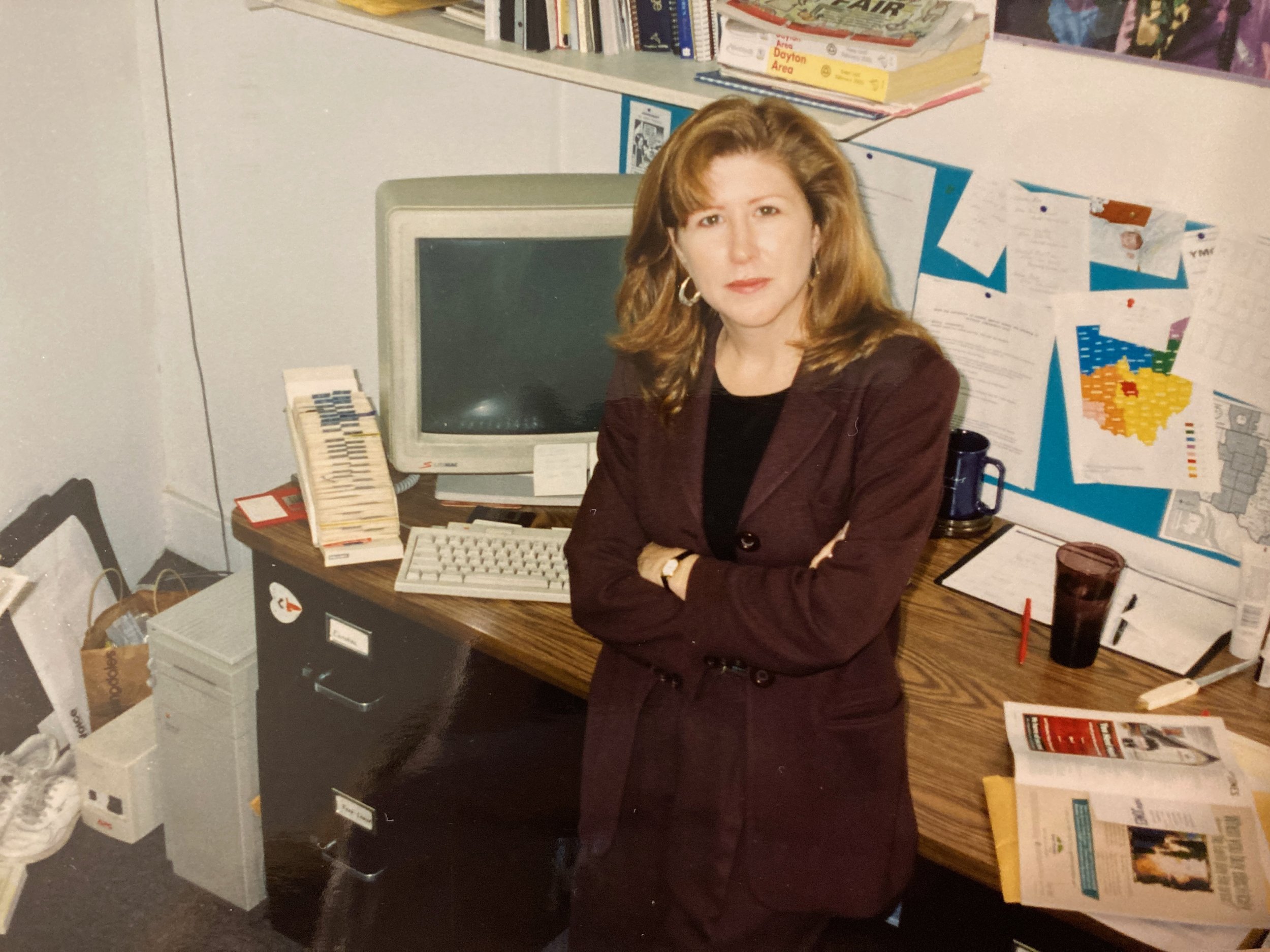Persuasive: 40 Lessons
in Communicating for the Common Good
Author’s Overview of Contents
Part One: Foundations
Early career experiences can teach critical lessons about work and working —and oneself. That was true of my first jobs and my first decade in journalism. I reported on the punishing dangers of coal liquefaction, interviewed dissidents behind the iron curtain in the former Soviet Union, reported on conditions that led to an FBI seige at Akwesasne Nation, and experienced a “stop the presses” moment when the space shuttle Challenger exploded. In these first seven chapters, I share lessons that would influence the rest of my career.
Sample lesson: Listen to those who challenge you, and go to places where you are not comfortable. That is when and where you will learn the most.
Photo: The author’s father, Tom McMullen, with his fleet of trucks at the service station he managed in Pittsburgh where the author worked her first job in the 1970s.
Part Two: The Dayton Voice
These six chapters focus on running a scrappy newsweekly in an edgy city on a shoe string, all while raising a family of foster daughters, finishing a graduate degree in communications, and eventually having our own child. It was a frequently punishing work schedule, but the stories we did! One led to the release of two people serving life sentences for false charges of child sexual abuse. Others led to the firing of corrupt officials and spotlighted wrongdoing in public institutions. And the culture we built informed my management style for decades.
Sample Lesson: Honor the talents of your staff team. Every ability they bring, no matter how seemingly unrelated to the primary work, can help you achieve your mission while building a solid and unique work culture.
Photo: The author, with her rolodex, phone book and chunky Apple computer, when she served as editor and co-publisher of The Dayton Voice in the 1990s.
Part Three: The Labor Movement
Armed with a graduate degree and nearly 20 years experience, I started working in the labor movement. Challenges reflected in these nine chapters range from fighting major hospital chains to getting Barack Obama elected to the U.S. Senate. Adventures ranged from staffing a press conference where Neil Young brought the house down to toasting Bianca Jagger at the U.N. Climate talks. Exposure to communication theory led to my development of the Persuasion Matrix, which I applied to numerous labor-focused campaigns.
Sample Lesson: A campaign can be effective on many fronts but still not be successful. David beating Goliath is a big deal because Goliath is more likely to win. And often he does.
Photo: SEIU President Andy Stern, far left, with musicians prior to the Take Back Labor Day concert in 2008. Left to right: Mos Def, Tom Morello, Steve Earle, Allison Moorer, and Billy Bragg.
Part Four: School Reform
From struggling with Dayton Public Schools over educating my foster daughters, to developing an alternative “thin contract” for teachers’ unions nationwide, school reform efforts were part of my personal and eventually professional life for decades. This culminated with working with Michelle Rhee, the controversial chancellor of Washington, DC Public Schools. Powerful lessons in changing large public institutions, communication strategy, and management emerged from this work.
Sample lesson: You don’t need everyone to love you, but you always need other people to be successful.
Photo: Halloween was a big deal at DC Public Schools administrative offices. Here, in 2010, the communication team dressed as rock stars because they were.
Part Five: The Obama Administration
When working on the federal level, every communication, persuasion and management skill is put to the test. It is the ultimate “at scale” experience. I publicly battled with the Catholic bishops over reproductive rights, managed media work over a flood of unaccompanied children entering the U.S. across the Mexican border, and routinely interacted with the White House. Robust management lessons are shared in this seven-chapter section, from strategies for addressing low-performers, to developing strong internal communication capacity.
Sample Lesson: One of the hardest responsibilities of a supervisor is to address problem employees. But it is critical to do so—for the sake of the mission, the organization, and your other employees.
Photo: Administration for Children and Families staff outside the West Wing after a meeting with philanthropic leaders in the Eisenhower Executive Office Building in 2016.
Part Six: Never Stop Learning
Returning home to Chicago, the lessons keep coming in the form of building a communication shop from scratch at a prestigious research center, to making the best use of new communication channels and tools, including AI-generated large language models. This five-chapter section wraps up with a guide to developing a robust and evidence-based communication plan, based on many of the experiences shared in this book. A closing chapter puts work and career in the context of family, showing how critical aspects of personal and professional life intersect at potential advantage to both.
Sample Lesson: Use what the research has taught us about persuasion to make your communication campaigns as strategic as possible. Avoid wasting time and energy on tactics outside of that strategy.
Photo: In 2018, spokespeople with lived experience speak at a press conference about new research on the prevalence of youth homelessness.





